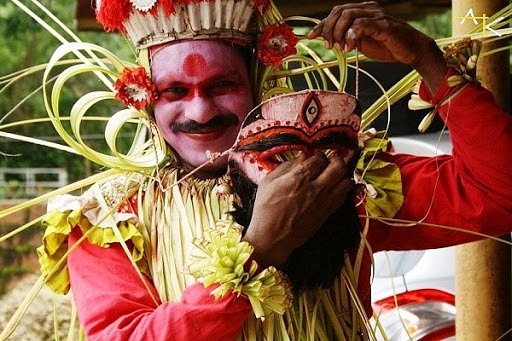News Brief
In Pictures: Full Of Colours, Rhythm And Dynamism, Folk Dance Aati Kalenja Of Tulu Nadu Brings Nature To Our Doors

Source: Arjun-Kurunji-Photo-Mechanic-473615542728022/Facebook
The ‘Aati’ season which falls in the months of July-August is bringing a festive delight to the region of Tulunadu.
The ‘Aati’ is the month of heavy rains in Tulu calendar. The calendar, one of the oldest traditional Indian solar calendars, is generally used in the regions of northern parts of Kasaragod District of Kerala, and Dakshina Kannada, Udupi Districts of Karnataka.
Though rain brings revival of nature, the month is also marked by natural calamities in the form of floods and landslides. Heavy rain also destroys the crops, and agriculture comes to a standstill. Floods also bring diseases and pests with them. Therefore, people worship the spirit of nature embodied by ‘Aati Kalenja’, which is believed to descend down to Parashurama Kshetra in the season.
The local Nalike community performs a ritualistic folk dance. Dressed up in an eco-friendly costume made of leaves and flowers, a majestic headgear called ‘Mudi’ made using stems of Ixora coccinea (Kepula in Kannada), the Kalenja makes for a spectacular sight.
With hands, legs and face painted with vibrant colours, a skirt made of tender fronds of coconut interlaced with banana sheath strands and a umbrella of dry palm leaves, the Kalenja visits houses of the people who feel blessed to have the opportunity to receive the spirit of nature at their doors.
Kalenja dances at the beats of ‘tembere’ and carries ritual water - a mix of turmeric, charcoal and tamarind, to ward off the evil spirits and misfortune. As a traditional healer, sometimes he also dispenses medicinal herbs to overcome illness. The accompanying drummer sings “Aateek Baththe Aati Kalenja”, a song which tells the story of the spirit.
The performance begins on poove — the day before the full moon, and continues till the end of the month.
Increasing urbanisation has put pressure on the folk art form that was, until recently, passed only orally from one generation to another. With paddy fields disappearing around the countryside, the dance is also threatened, mainly limited to areas relatively untouched by urbanisation.
Support Swarajya's 50 Ground Reports Project & Sponsor A Story
Every general election Swarajya does a 50 ground reports project.
Aimed only at serious readers and those who appreciate the nuances of political undercurrents, the project provides a sense of India's electoral landscape. As you know, these reports are produced after considerable investment of travel, time and effort on the ground.
This time too we've kicked off the project in style and have covered over 30 constituencies already. If you're someone who appreciates such work and have enjoyed our coverage please consider sponsoring a ground report for just Rs 2999 to Rs 19,999 - it goes a long way in helping us produce more quality reportage.
You can also back this project by becoming a subscriber for as little as Rs 999 - so do click on this links and choose a plan that suits you and back us.
Click below to contribute.
Latest